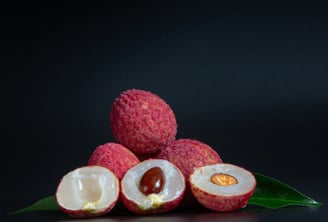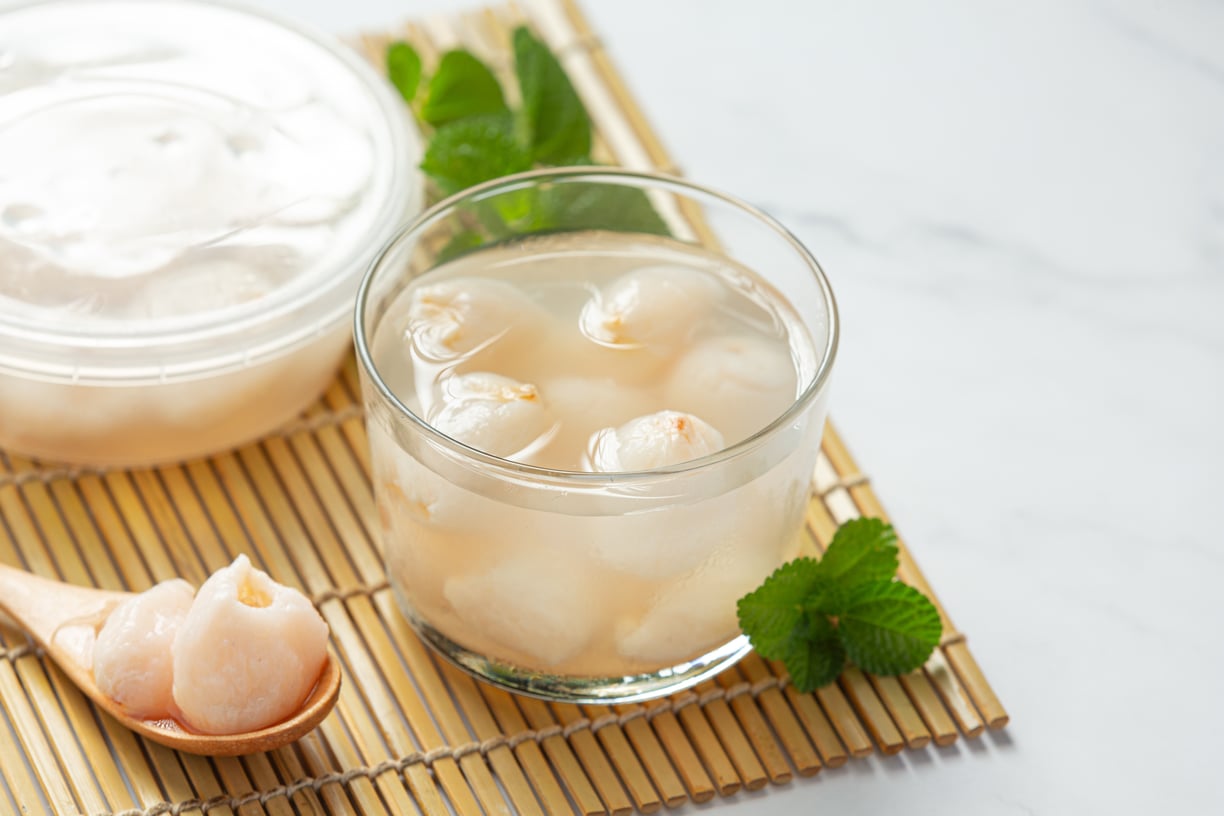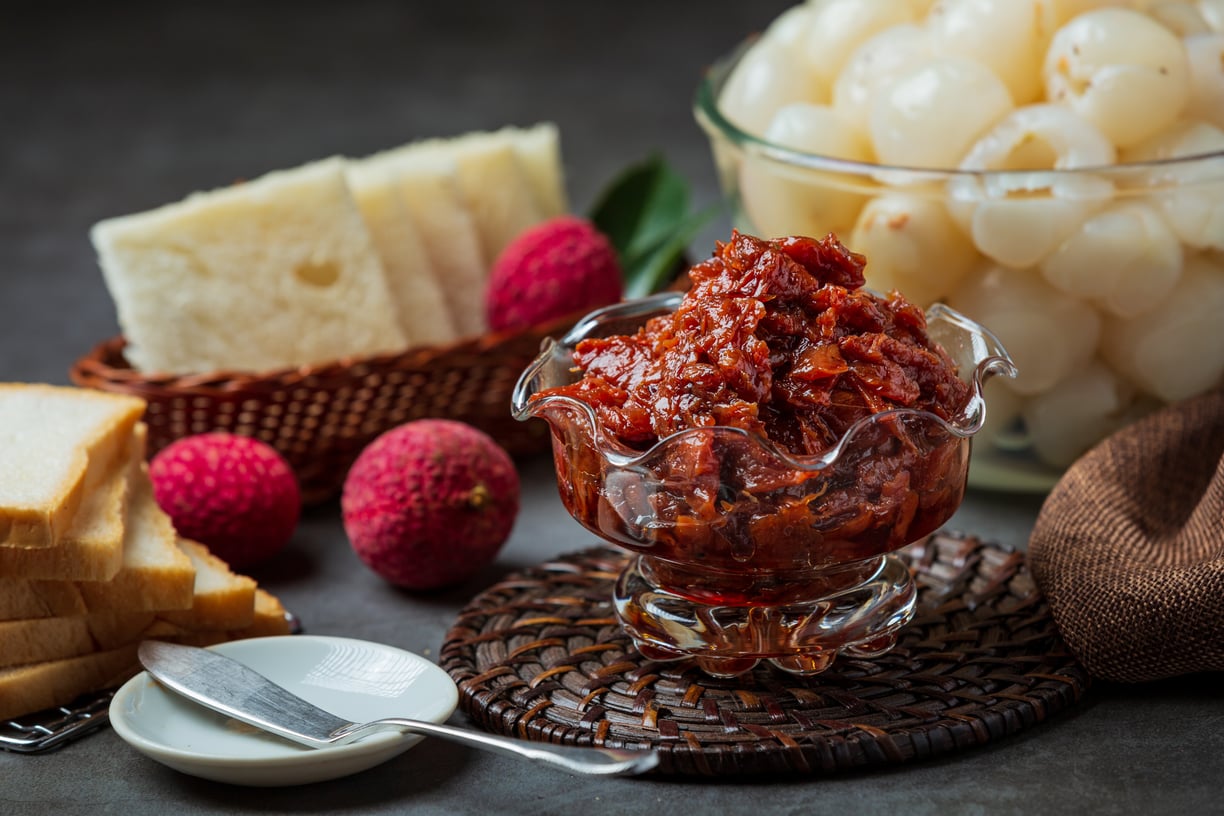Lychee
Lychee is the sole member of the genus Litchi in the soapberry family, Sapindaceae. Other popular fruits in this family include rambutan & longan. It’s a tropical tree native to the Guangdong & Fujian provinces of China, where cultivation is documented from 1059 AD. China is the main producer of lychees, followed by
HEALTHY & FUN FRUITY FACTS


Lychee
Lychee is the sole member of the genus Litchi in the soapberry family, Sapindaceae. Other popular fruits in this family include rambutan & longan. It’s a tropical tree native to the Guangdong & Fujian provinces of China, where cultivation is documented from 1059 AD.
China is the main producer of lychees, followed by India, other countries in Southeast Asia, the Indian Subcontinent, South Africa, Vietnam, Indonesia, Australia, & the United States.
Unofficial records in China refer to the lychee as far back as 2000 BC.
Wild lychee trees still grow in parts of southern China & on Hainan Island.
There are many stories in the Chinese tradition of lychee being used as a delicacy in the Chinese Imperial Court. In the 1st century, fresh lychees were in such demand at the Chinese Imperial Court that a special courier service with fast horses would bring the fresh fruit from Guangdong.
It was the favorite fruit of Emperor Li Longji’s favored concubine Yang Yuhuan. The emperor had the fruit delivered at great expense to the capital.
The lychee attracted the attention of European travelers, such as Juan Gonzalez de Mendoza, based on the reports of Spanish friars who had visited China in the 1570s giving the fruit high praise.
Lychee was first described & introduced to the West in 1656 by Michael Boym, a Polish Jesuit missionary, who was at the time part of the Polish-Lithuanian Commonwealth.
The lychee was scientifically described by Pierre Sonnerat on a return from his travels to China & Southeast Asia.
Lychee requires cold weather during the winter for the successful development of flower buds & warm, moist weather with high temperatures during the summer for the production of fruit.
Lychee is a medium-sized tree that can reach 40 to 50 feet in height.
It has a short trunk covered with smooth, grey or black bark & low spreading, brownish-red branches.
Lychee develops evergreen, shiny, leathery, green leaves composed of 2 to 4 thin leaflets arranged in pairs.
It produces individual male & female flowers, meaning it’s a monoecious plant, gathered in long terminal clusters composed of up to 3,000 flowers.
It blooms from November to February in the northern hemisphere & from April to August in the southern hemisphere. The flowers are fragrant & they attract bees, who are the main pollinators of lychee.
Lychee looks like a bumpy strawberry with roundish, sharp protuberances. Botanically speaking, lychee is a drupe. The fruit grows arranged in dense clusters of 3 to 50; it ripens 100 to 120 days after pollination. Lychee is known as the “Chinese strawberry” because it comes from China & looks like a strawberry. The fruit is a symbol of love & romance in China.
Lychee has rough skin on the surface that can be pink or reddish-brown colored. The edible flesh is succulent, white & translucent. Each lychee fruit has one large, shiny brown seed.
Lychee has a floral aroma & a sweet taste that resembles a mix of grape & pear. The flesh has a texture similar to that of a grape.
Lychee seeds contain toxic compounds that can induce unpleasant side effects in the digestive system after consumption.
It’s a natural diuretic. It alleviates pain associated with kidney stones & reduces the formation of blood clots.
Lychee is a perennial plant that can survive around 1,000 years in the wild.
It can be eaten fresh, in the form of fruit salads, or it can be used in ice cream, juice, jelly, jam, syrup, & various beverages.
Lychee is a rich source of dietary fibers, vitamins C, B1, B3, B9 & minerals such as copper, potassium, calcium & magnesium. 100g of the fruit contains 66 calories.
Lychees are primarily composed of water & carbs, most of which are sugars. Compared to many other fruits, they’re low in fiber. They’re also high in vitamin C & offer decent amounts of copper & potassium.


The health effects of lychees have not been studied directly. However, they contain several nutrients & antioxidants that are important for health.
Like most fruits & vegetables, lychees are a good source of antioxidants & other healthy plant compounds. These include epicatechin & rutin. Fresh lychees don’t contain any Oligonol, as is often claimed.
A 2015 study indicates that lychee flesh is a rich source of plant compounds called proanthocyanidins. According to the study, proanthocyanidins may have the following health benefits:
antioxidant
anti-diabetic
anti-angiogenic
anti-carcinogenic
anti-inflammatory
cardioprotective
Proanthocyanidins are also present in other fruits such as apples, blueberries, & grapes.
Lychee is quite low in calories; 100 grams contains only 66 calories. It contains no saturated fats or cholesterol & is rich in dietary fiber, thus making it an ideal option for those who are trying to shed some pounds.
Lychee has a significant amount of water content & fiber, which has a soothing effect on the stomach. The fiber regulates bowel movements by ensuring its smooth passage through the digestive tract. It also adds bulk to the stool & increases your digestive health.
Lychee proves to be a good antioxidant as it contains a high amount of Vitamin C that improves the immune function of the body.
Lychee contains good amounts of flavanol, which is known to treat inflammation & tissue damage caused by inflammation.
Lychee is loaded with essential nutrients like magnesium, phosphorus, iron, manganese & copper. These minerals are known to increase calcium absorption in the bones & improve the health of the bones.
Lychee carries balanced potassium & sodium levels, which help the blood vessels to relax & maintain proper blood pressure.
According to several researchers, lychees are loaded with antioxidants which help in promoting cardiovascular health.
You can find fresh lychee in some grocery stores. Asian supermarkets often sell canned & dried lychees. Canned lychees often have sugar added. Check the label to see if they’re in sugar-sweetened syrup or their own juice.
In the US, lychee season begins in May & runs through the summer. You can refrigerate fresh lychee fruit for 5 to 10 days. It can also be frozen whole with the peel on. Dried lychee can be stored for up to 1 year at room temperature.
Some ways to use fresh or canned lychee include:
Using lychee juice (from a can of lychee fruit) to make a cocktail
Stir-frying it with pork, chicken, or shrimp
Chopping up lychee & mixing it with avocado, lime juice, cilantro, & onion to make a salsa
Make a fruit salad with lychee fruit, pineapple chunks, melon, & other favorite fruits.


